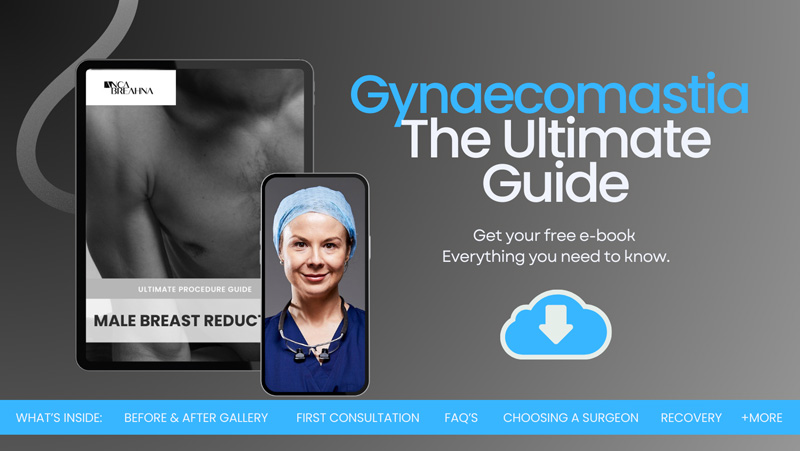
- Treatments to Minimise Scars after Gynaecomastia
- Download Anca's Guide to Gynaecomastia
- What is Gynaecomastia?
- What Are Gynaecomastia Surgery Scars Like?
- Factors Influencing Scar Formation
- Options to Reduce Scars after Gynaecomastia
- Topical Treatments
- Medical Procedures to Reduce Gynaecomastia Scars
- · Laser Therapy
- · Microneedling
- · Steroid Injections
- Surgical Scar Revision Techniques
- · Scar Excision and Re-closure
- · Z-plasty and W-plasty Techniques
- · Skin Grafting for Wider Scars
- FAQs about Gynaecomastia Scars
- How long does it take for gynaecomastia surgery scars to fully heal?
- Are there any non-prescription remedies that can help with scar healing?
- Can exercise and physical activity affect scar healing?
- What role does genetics play in scar formation?
- Are there specific lifestyle changes that can improve scar healing?
- Further Reading about Gynaecomastia with Consultant Plastic Surgeon Anca Breahna
- Medical References about Gynaecomastia Scars
Treatments to Minimise Scars after Gynaecomastia
Gynaecomastia surgery, also known as male breast reduction surgery, is a procedure that can significantly improve the quality of life for men who experience enlarged breast tissue. While the surgery can offer great relief and enhanced appearance, one concern that often arises is the scars that remain post-surgery. Understanding what these scars are like, where they are typically located, and how they can be managed is essential for anyone considering this procedure. In this blog, Consultant Plastic Surgeon Anca Breahna aims to provide a complete overview of gynaecomastia surgery scars and the various treatments available to minimise their appearance.
Download Anca’s Guide to Gynaecomastia

What is Gynaecomastia?
Gynaecomastia refers to the enlargement of breast tissue in males, a condition that can occur due to hormonal imbalances, certain medications, or underlying health issues. It is relatively common and can affect one or both breasts, sometimes unevenly. This condition can lead to physical discomfort and emotional distress, prompting many to seek surgical intervention. Gynaecomastia surgery involves the removal of excess breast tissue and fat, sometimes combined with liposuction, to achieve a flatter, more masculine chest contour. There are different types of gyno – glandular vs. fatty tissue gynaecomastia, and understanding which type you have can influence the treatment approach.
What Are Gynaecomastia Surgery Scars Like?
- Common Scar Locations: Scars from gynaecomastia surgery are generally located in areas that are easily concealed. The most common locations include around the areola (the dark skin surrounding the nipple), along the natural creases of the chest, and occasionally in the armpits. The placement of the scars depends largely on the surgical technique used and the extent of tissue removal required.
- Appearance of Scars Over Time: Initially, gynaecomastia surgery scars will appear red and slightly raised. This is a normal part of the healing process and usually subsides over several months. Over time, these scars typically become flatter and lighter in colour, blending more seamlessly with the surrounding skin. The final appearance of scars can take up to a year or more to fully mature, varying greatly depending on individual healing responses and skin types.
Factors Influencing Scar Formation
- Individual Skin Type: The type of skin you have can significantly influence how your scars heal and appear over time. Some people have skin that heals quickly and efficiently, while others may experience prolonged redness and thickness in their scars.
- Genetics and Scarring: Genetics play a crucial role in how your body heals and scars. If you have a family history of keloid or hypertrophic scars, you may be at higher risk for developing prominent scars after gynaecomastia surgery. It’s important to discuss your medical history with Anca to anticipate any potential complications.
- Skin Elasticity and Healing: Skin elasticity also affects how scars form and heal. More elastic skin tends to heal better and with less noticeable scarring. Conversely, skin that is less elastic may take longer to heal and may be prone to more visible scarring. Maintaining healthy skin through proper hydration and nutrition can support better healing.
- Surgical Techniques: The techniques used by Anca can impact the extent and visibility of scarring. Minimally invasive methods that require smaller incisions typically result in smaller, less noticeable scars.
- Post-Surgical Care: Proper post-surgical care is essential for optimal scar healing. Following Anca’s instructions regarding wound care, avoiding sun exposure, and using recommended topical treatments can make a significant difference in how your scars heal.
Options to Reduce Scars after Gynaecomastia
Topical Treatments
Topical treatments are widely used to improve the appearance of scars after gynaecomastia surgery. They can be effective in reducing the size, colour, and texture of scars, helping them blend more seamlessly with the surrounding skin. Here are some commonly used topical treatments:
- Silicone Gels and Sheets
Silicone gels and sheets are among the most effective and widely recommended options for scar management. These products create a protective barrier over the scar, which helps to retain moisture and regulate collagen production. By maintaining an optimal hydration level, silicone gels and sheets can soften and flatten raised scars, making them less noticeable. Silicone sheets, which are applied directly to the scar, provide continuous pressure and hydration, which can be particularly beneficial for larger or more prominent scars. They are often worn for several hours a day, or even overnight, to maximise their effectiveness. Silicone gels are convenient for use on scars in more visible or awkward locations, as they can be easily applied and left to dry.
- Topical Steroids and Creams
Topical steroids and creams are another common treatment option for scars. These products work by reducing inflammation and preventing the overproduction of collagen, which can lead to raised scars such as hypertrophic scars and keloids. Topical steroids are usually prescribed in the form of creams or ointments and are applied directly to the scarred area. They help to soften and flatten the scar tissue, making it less prominent. These treatments are most effective when used during the early stages of scar formation, as they can prevent the development of excessive scar tissue. However, it is important to use topical steroids under Anca’s guidance, as improper use can lead to side effects such as skin thinning.
Medical Procedures to Reduce Gynaecomastia Scars
· Laser Therapy
Laser therapy is a popular option for reducing the appearance of scars. It works by targeting the pigment in the scar tissue, breaking it down, and promoting the growth of new, healthy skin cells. Multiple sessions may be required for optimal results, and the type of laser used can vary depending on the scar’s characteristics.
· Microneedling
Microneedling involves creating tiny punctures in the skin using fine needles, which stimulates the body’s natural healing process and promotes collagen production. This procedure can help improve the texture and appearance of scars, making them less noticeable over time. It is often combined with other treatments, such as topical serums, to enhance results.
· Steroid Injections
Steroid injections are used to treat hypertrophic and keloid scars, which are raised and sometimes painful. The steroids help reduce inflammation and flatten the scar tissue. Multiple injections may be needed, and the treatment plan should be discussed with Anca to ensure it is suitable for your specific scar type.
Surgical Scar Revision Techniques
When it comes to addressing scars from gynaecomastia surgery, several surgical revision techniques can be considered to improve their appearance and functionality. These techniques are tailored to the specific characteristics of the scars, such as their size, location, and severity.
· Scar Excision and Re-closure
Scar excision and re-closure is a technique where Anca removes the old scar tissue and carefully re-closes the wound. This method is typically employed for scars that are particularly wide, irregular, or have healed poorly. The primary goal of this procedure is to create a new, more aesthetically pleasing scar.
During the procedure, Anca makes a precise incision to remove the scar tissue. The new wound edges are then meticulously aligned and closed using fine sutures. By minimising the tension on the wound edges, this technique promotes better healing and reduces the likelihood of a prominent scar. The new scar will initially appear fresh but is expected to heal more smoothly and be less noticeable than the original one.
Scar excision and re-closure can be particularly beneficial for patients who have developed hypertrophic scars or keloids, as these types of scars tend to benefit from a fresh surgical approach. This technique requires careful post-operative care to ensure optimal healing and prevent the recurrence of problematic scarring.
· Z-plasty and W-plasty Techniques
Z-plasty is an advanced surgical technique used to improve the appearance of scars by changing their direction and breaking up their linear nature. This method involves creating a Z-shaped incision over the scar. The central limb of the Z is aligned with the scar, and the two triangular flaps on either side are then transposed.
The primary advantage of Z-plasty is that it can realign the scar along natural skin folds or tension lines, making it less noticeable. Additionally, Z-plasty can help release contractures, which are tight bands of scar tissue that can restrict movement. By altering the tension and orientation of the scar, Z-plasty can significantly enhance the aesthetic outcome and functionality of the scarred area.
W-plasty is another technique aimed at improving the appearance of scars, particularly those that are long and straight. This method involves making a series of small, angled incisions that form a W pattern along the length of the scar. The resulting small triangular flaps of skin are then repositioned and sutured in place.
W-plasty works by breaking up the straight line of the scar into smaller, less noticeable segments. This technique is especially effective for scars that are highly visible or cross important aesthetic units of the body, such as the chest. By redistributing the tension and creating a more irregular scar line, W-plasty helps the scar blend more naturally with the surrounding skin.
· Skin Grafting for Wider Scars
Skin grafting is a more extensive procedure used for large or wide scars that cannot be effectively treated with simpler techniques. This process involves transplanting healthy skin from one part of the body (the donor site) to cover the scarred area.
There are two main types of skin grafts: split-thickness and full-thickness grafts. Split-thickness grafts include the top layers of the skin (epidermis and part of the dermis) and are used for larger surface areas. Full-thickness grafts, on the other hand, involve the entire dermis and are used for smaller areas where a better cosmetic match is needed.
During the procedure, Anca carefully removes the scar tissue and prepares the recipient site. The graft is then placed over the area and secured with sutures or staples. The grafted skin requires a period of immobilisation to ensure proper adherence and vascularisation. Post-operative care is critical to prevent complications such as infection or graft failure.
Skin grafting can be an effective solution for improving the appearance and function of wide scars, but it is more invasive and requires a longer recovery period compared to other scar revision techniques. The success of the graft depends on various factors, including the health of the donor site, the recipient site, and adherence to post-surgical care instructions.
FAQs about Gynaecomastia Scars
How long does it take for gynaecomastia surgery scars to fully heal?
- Gynaecomastia surgery scars can take up to a year or more to fully mature and settle. Initially, scars may appear red and raised, but over time, they typically become flatter and lighter in colour. The healing process varies from person to person, depending on factors like skin type, age, and overall health. Consistent post-operative care and following Anca’s advice can aid in faster and more effective healing.
Are there any non-prescription remedies that can help with scar healing?
- Yes, in addition to medical treatments, several non-prescription remedies can aid in scar healing. These include natural oils like rosehip oil, vitamin E oil, and aloe vera, which are known for their skin-healing properties. Applying these oils can keep the skin hydrated and promote better healing. Additionally, over-the-counter scar creams containing ingredients like onion extract and hyaluronic acid can also help improve the appearance of scars.
Can exercise and physical activity affect scar healing?
- Physical activity, especially exercises that target the chest area, should be approached with caution after gynaecomastia surgery. Strenuous activities can strain the surgical site and potentially worsen scarring. It’s essential to follow Anca’s guidelines on when to resume exercise and start with light activities. Gradual reintroduction of physical activity, combined with proper scar care, can help in the healing process without compromising the results.
What role does genetics play in scar formation?
- Genetics significantly influence how your body heals and forms scars. If you have a family history of keloids or hypertrophic scars, you may be more prone to developing similar scars after surgery. Understanding your genetic predisposition can help in anticipating potential scarring issues and taking preventive measures. Discussing your family history with Anca can also help in choosing the most suitable scar management strategies.
Are there specific lifestyle changes that can improve scar healing?
- Several lifestyle changes can positively impact scar healing. Avoiding smoking and excessive alcohol consumption is crucial, as these habits can impair blood circulation and delay healing. Maintaining a healthy diet rich in vitamins and minerals supports skin regeneration. Additionally, managing stress through relaxation techniques and ensuring adequate sleep can enhance your body’s overall healing capabilities. Staying well-hydrated and protecting your scars from sun exposure by using sunscreen can also prevent hyperpigmentation and improve the final appearance of the scars.
Further Reading about Gynaecomastia with Consultant Plastic Surgeon Anca Breahna
- Read more about Who is the Best Gynaecomastia Surgeon in the World?
- Read more about Recovery after Gynaecomastia Surgery
- Read more about When Can I Exercise after Gynaecomastia
- Read more about How to Get Rid of Man Boobs – Causes and Treatment Options
- Read more about How to Get Rid of Puffy Nipples in Men
- Read more about Types of Gyno – Glandular vs. Fatty Tissue Gynaecomastia
Medical References about Gynaecomastia Scars
- New Classification and Treatment Protocol for Gynecomastia – Oxford Academic
- Gynecomastia: Surgery, treatment, causes, and symptoms – Medical News Today
- Male Breast Reduction Guide | Gynecomastia Surgery Guide – American Board of Cosmetic Surgery
- Gynecomastia Surgery (Male Breast Reduction) – Cleveland Clinic
- Breast reduction (male) – NHS


 Ms Anca Breahna, PhD, MSc, FEBOPRAS, FRCS (Plast) is a highly regarded Consultant Plastic Surgeon specialising in the field of Aesthetic and Reconstructive Plastic Surgery. Anca performs a range of
Ms Anca Breahna, PhD, MSc, FEBOPRAS, FRCS (Plast) is a highly regarded Consultant Plastic Surgeon specialising in the field of Aesthetic and Reconstructive Plastic Surgery. Anca performs a range of 